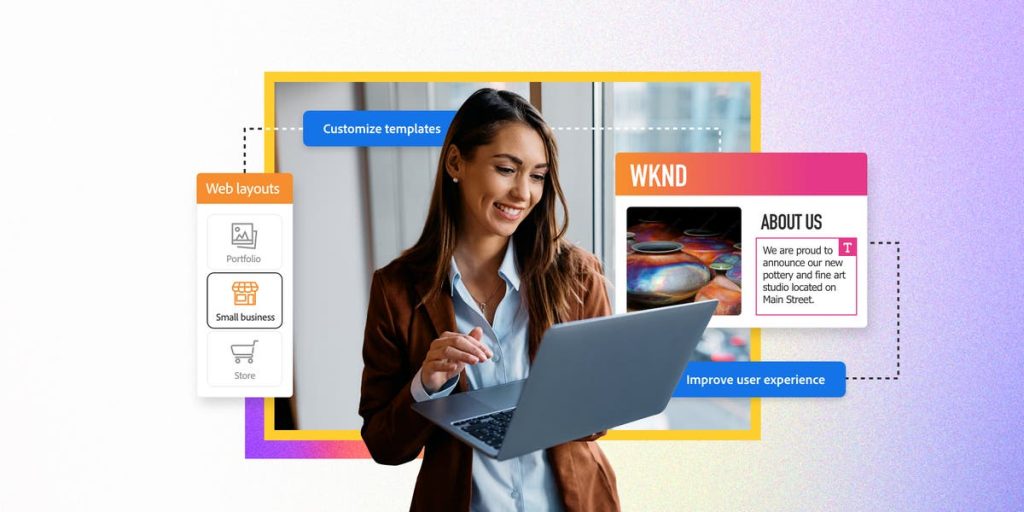In the realm of digital advancement, the meticulous process of planning a WordPress website unfolds as a strategic journey from inception to execution. Each step in this guide peels back the layers of complexity, shedding light on the foundational elements that underpin a successful online presence. From conceptualizing a unique website design to seamlessly integrating cutting-edge development tools, the roadmap laid out in this piece offers a structured approach to harnessing the full potential of WordPress. As we explore the nuances of custom website planning, a wealth of insights awaits those keen on unraveling the intricacies of crafting a digital footprint that resonates with precision and purpose.
Understanding the Basics of Custom WordPress Website Development
As we embark on the exploration of WordPress custom development basics, we uncover key features that distinguish WordPress in the realm of website creation. Understanding the advantages that WordPress offers for your online presence is crucial in making informed decisions about your website’s development. By dissecting the intricacies of custom WordPress development, we aim to provide a clear path towards harnessing the full potential of this versatile platform.
Key Features of WordPress Custom Development
A fundamental aspect of custom WordPress website development lies in understanding the key features that differentiate it from standard website building platforms. When delving into WordPress custom development, here are some key features to consider:
- Flexibility: Tailoring every aspect of the website to align with specific business requirements.
- Scalability: Ability to expand the website’s functionalities as the business grows.
- Customization: Creating unique designs and features that set the website apart.
- SEO-Friendly: Implementing SEO best practices to enhance visibility and ranking.
- Security: Incorporating robust security measures to protect the website from potential threats.
Advantages of Choosing WordPress for Your Website
Choosing WordPress for your website offers a multitude of advantages, particularly when delving into the basics of custom WordPress website development. WordPress is renowned for its flexibility, scalability, ease of use, and extensive plugin ecosystem. Here are some key advantages of choosing WordPress for your website:
| Advantages of WordPress for Your Website | Description |
|---|---|
| Flexibility | Easily customizable to suit various needs. |
| Scalability | Can accommodate growth and increased traffic. |
| User-Friendly Interface | Intuitive dashboard for easy content management. |
| Plugin Support | Wide range of plugins for added functionality. |
These advantages make WordPress a top choice for individuals and businesses looking to create a dynamic and tailored online presence.

The Initial Steps in Website Planning
As you embark on the journey of website planning, the initial steps play a crucial role in shaping the success of your online presence. Setting clear objectives for your website provides a roadmap for your development process, ensuring alignment with your business goals. Research and drawing inspiration are foundational tasks that lay the groundwork for a well-thought-out and effective website strategy.
Essential Steps in the WordPress Website Planning Process
| Step Number | Phase | Key Activities | Outcome |
|---|---|---|---|
| 1 | Discovery | Identify goals, target audience, and key features | Project brief and requirements |
| 2 | Design | Create wireframes and mockups | Visual blueprint of the site |
| 3 | Development | Code custom themes and plugins | Functional and stylized website |
| 4 | Testing | Conduct QA and user testing | Error-free and user-friendly site |
| 5 | Launch | Optimize SEO and make the site live | Website goes public |
| 6 | Maintenance | Regular updates and backups | Ongoing smooth site operation |
Setting Clear Objectives for Your Website
Establishing concrete goals is pivotal in the foundational stages of website planning, as it provides a strategic direction for the development process. When setting clear objectives for your website, consider the following:
- Define the purpose of your website.
- Identify your target audience.
- Determine the key actions you want visitors to take.
- Set measurable goals to track success.
- Ensure that your objectives align with your overall business strategy.
These steps will not only guide the design and development of your WordPress website but also help you create a user-centric online platform that effectively communicates your brand message and drives desired outcomes.
Research and Inspiration: Laying the Groundwork
Conducting thorough research and seeking inspiration are crucial initial steps in the meticulous process of website planning. Research helps in understanding target audiences, industry trends, and competitors, providing a solid foundation for the website’s strategic direction. Inspiration, on the other hand, fuels creativity and innovation, leading to unique design and content ideas that can set a website apart. By combining research and inspiration effectively, website planners can lay the groundwork for a successful and impactful online presence.
| Research | Inspiration |
|---|---|
| Identify target audiences | Explore design trends |
| Analyze competitor websites | Review creative portfolios |
| Study industry best practices | Attend web design conferences |
Designing Your Custom WordPress Site
Let’s focus on the essential aspect of custom WordPress site design which involves tailoring layouts and user interfaces to align with your brand’s aesthetic and functionality requirements. The design phase plays a crucial role in creating a visually appealing and user-friendly website that engages visitors and drives conversions. By carefully customizing these elements, you can enhance user experience and establish a strong online presence for your business.
Customizing Layouts and User Interfaces
When designing a custom WordPress site, it is crucial to prioritize responsive design considerations to ensure optimal viewing experiences across various devices. Incorporating interactive elements can enhance user engagement and create a more dynamic browsing experience. Focusing on user experience is key to developing a website that not only looks visually appealing but also functions intuitively to meet the needs of visitors.

Responsive Design Considerations
During the process of designing your custom WordPress site, it is crucial to carefully consider responsive design principles to ensure optimal user experiences across various devices and screen sizes.
- Fluid Layouts: Ensure content adapts seamlessly to different screen sizes.
- Media Queries: Use CSS rules to adjust styles based on device characteristics.
- Flexible Images: Scale images proportionally to prevent distortion.
- Viewport Meta Tag: Control the viewport’s width and scaling on mobile browsers.
- Testing: Regularly test site responsiveness on different devices.
Interactive Elements and User Experience
In crafting a custom WordPress site, deliberate attention to interactive elements and user experience plays a pivotal role in enhancing engagement and usability for visitors. By incorporating intuitive navigation, responsive design, visually appealing graphics, and interactive features like sliders or pop-ups, website creators can create a dynamic and user-friendly interface. These elements not only captivate visitors but also contribute to a seamless and enjoyable browsing experience, ultimately driving user engagement and satisfaction.
Essential WordPress Development Tools and Resources
To excel in WordPress website development, utilizing a curated selection of essential tools and resources is paramount for achieving optimal results. Here are five must-have tools and resources for WordPress development:
- Local Development Environment: Setting up a local server environment using tools like Local by Flywheel or XAMPP allows for offline website development and testing before going live.
- Code Editors: Utilize code editors like Visual Studio Code, Sublime Text, or Atom for writing and editing your website’s code efficiently with features like syntax highlighting and auto-completion.
- Version Control System: Git, coupled with platforms like GitHub or Bitbucket, enables tracking changes, collaborating with team members, and easily reverting to previous versions of your WordPress website.
- Page Builders: Tools like Elementor, Divi, or Beaver Builder provide drag-and-drop functionality, making it easier to design visually appealing pages without extensive coding knowledge.
- SEO Plugins: Incorporate SEO plugins such as Yoast SEO or Rank Math to optimize your website for search engines, improve visibility, and drive organic traffic to your WordPress site.
These tools and resources are instrumental in streamlining the development process, enhancing productivity, and ensuring a successful WordPress website launch.
Comparison of Top WordPress Development Tools
| Tool | Type | Use Case | Compatibility |
|---|---|---|---|
| Elementor | Page Builder | Designing responsive website layouts | WordPress 5.0+ |
| WPForms | Form Builder | Creating custom forms for lead generation | WordPress 4.9+ |
| Yoast SEO | SEO Plugin | Optimizing content and managing SEO settings | WordPress 5.2+ |
| WooCommerce | E-commerce Plugin | Building and managing online stores | WordPress 5.0+ |
| WP Rocket | Caching Plugin | Improving website speed and performance | WordPress 4.5+ |
Developing Your Custom WordPress Website
Moving on from the foundational tools and resources discussed in the previous section, the focus now shifts towards the practical implementation of developing a custom WordPress website tailored to your specific needs and objectives. Developing a custom WordPress website involves a series of strategic steps to ensure a seamless and effective online presence.
Firstly, it is crucial to define the website’s purpose and target audience. Understanding the core objectives of the website will guide all subsequent development decisions. Next, the website’s design and layout should be carefully crafted to align with the brand identity and user experience goals. This includes selecting a suitable theme, customizing layouts, and optimizing for mobile responsiveness.
In terms of functionality, plugins play a vital role in extending the capabilities of a WordPress website. Careful selection and integration of plugins are essential to add features such as contact forms, social media integration, SEO optimization, and more.
Furthermore, content creation is a key aspect of developing a custom WordPress website. Compelling and relevant content not only engages visitors but also enhances SEO performance. Regularly updating and maintaining content is essential for ensuring the website remains fresh and relevant.
Testing and Launching Your WordPress Website
As you progress through the final stages of your WordPress website development, ensuring quality assurance remains paramount. By meticulously testing your website across various devices and browsers, you can guarantee a seamless user experience. Moreover, preparing a comprehensive checklist for the website launch will help you address any lingering issues and ensure a successful unveiling of your WordPress site.
Quality Assurance Throughout the Website Planning Process
During the website planning process for your WordPress site, ensuring quality assurance through rigorous testing and a successful launch is paramount to guarantee a seamless user experience and optimal functionality. It is essential to conduct thorough testing at various stages of development to identify and rectify any issues promptly. Here are five key aspects to focus on during quality assurance:
- Cross-browser compatibility testing
- Mobile responsiveness checks
- Functionality testing for all features and plugins
- Performance optimization assessments
- Security audits and vulnerability scans
Preparing for Website Launch: A Checklist
In the final stages of WordPress website development, meticulous attention to detail in testing and preparing for launch is essential to ensure a seamless user experience and optimal functionality. Prior to the website going live, thorough testing should be conducted to address any technical issues, ensure responsive design across devices, and confirm compatibility with different browsers. It is crucial to verify that all links are working correctly, images are optimized for fast loading times, and content is error-free.
Additionally, implementing proper security measures, such as SSL certificates, and setting up backups are vital steps to safeguard the website’s data. By following a comprehensive checklist covering these aspects, you can confidently launch your WordPress website with confidence and provide visitors with a positive browsing experience.
Maintaining and Updating Your WordPress Website
Regular maintenance and timely updates are imperative for ensuring the optimal performance and security of your WordPress website. Neglecting these crucial tasks can leave your site vulnerable to security breaches, performance issues, and compatibility problems. To keep your WordPress website running smoothly and securely, follow these essential maintenance practices:
- Regular Backups: Schedule regular backups of your website data and files to prevent data loss in case of emergencies.
- Plugin and Theme Updates: Keep your plugins and themes up to date to ensure compatibility, security, and performance improvements.
- Security Monitoring: Implement security measures such as firewalls, malware scans, and login protection to safeguard your website from cyber threats.
- Database Optimization: Regularly optimize your database to improve site speed and performance.
- Broken Link Checks: Periodically check for broken links on your website and fix them to maintain a seamless user experience.

SEO Optimization in Custom WordPress Development
Within the realm of custom WordPress development, SEO optimization plays a pivotal role in enhancing a website’s visibility and reach. By implementing SEO best practices tailored for WordPress, businesses can improve their online rankings and attract a more targeted audience. Utilizing specialized tools and plugins designed for SEO enhancement can further streamline the optimization process and maximize the website’s organic search performance.
SEO Best Practices for WordPress
Amidst the intricate web of custom WordPress development, implementing SEO best practices is paramount to ensuring optimal visibility and reach for your website. To enhance your WordPress site’s SEO performance, consider the following best practices:
- Keyword Research: Conduct thorough keyword research to target relevant terms.
- Quality Content: Create high-quality, engaging, and informative content for your audience.
- Meta Tags Optimization: Optimize meta titles and descriptions for improved click-through rates.
- Mobile Optimization: Ensure your website is mobile-friendly for a seamless user experience.
- Internal Linking: Utilize internal linking to establish website hierarchy and improve navigation.
Tools and Plugins for Enhancing SEO
Utilize a diverse range of tools and plugins strategically to enhance SEO performance in custom WordPress development. Plugins like Yoast SEO, All in One SEO Pack, and Rank Math offer features to optimize on-page content, meta descriptions, and generate XML sitemaps. Tools such as Google Analytics and Google Search Console provide valuable insights into website performance, keyword rankings, and user behavior. Additionally, incorporating schema markup using plugins like Schema Pro can enhance the visibility of content in search results. By leveraging these tools and plugins effectively, WordPress developers can improve website rankings, increase organic traffic, and establish a strong online presence for their clients, ultimately driving business growth and success.
Analyzing and Improving Website Performance
To enhance user experience and drive online success, optimizing website performance is crucial for achieving optimal functionality and efficiency. Analyzing and improving website performance involves a multifaceted approach aimed at enhancing speed, responsiveness, and overall user satisfaction. Here are some key strategies to consider:
- Implement Caching Mechanisms: Utilize caching plugins to store frequently accessed data, reducing server load and improving loading times.
- Optimize Images: Compress images to reduce file sizes without compromising quality, enhancing page loading speed.
- Minify CSS and JavaScript: Remove unnecessary characters from code files to decrease file sizes and improve website performance.
- Monitor Website Speed: Regularly test website speed using tools like Google PageSpeed Insights or GTmetrix to identify areas for improvement.
- Enhance Server Performance: Consider upgrading hosting plans or utilizing content delivery networks (CDNs) to ensure optimal server performance and website speed for users across different locations.
Future Trends in WordPress Development
In light of the ever-evolving landscape of web development, the trajectory of WordPress advancement holds key insights into upcoming trends and innovations. As we look towards the future of WordPress development, several trends are poised to shape the way websites are built and managed.
One prominent trend is the increasing focus on mobile responsiveness and performance optimization. With the growing prevalence of mobile device usage, ensuring that websites are not only visually appealing but also load quickly and function seamlessly on smartphones and tablets is paramount. WordPress developers are expected to prioritize mobile-first design principles and implement strategies to enhance the mobile user experience.
Additionally, the rise of artificial intelligence (AI) and machine learning is expected to influence WordPress development significantly. Integrating AI-powered chatbots for customer support, personalized content recommendations, and automated data analysis are just a few ways in which AI can revolutionize website functionality and user engagement.
Furthermore, the importance of security in WordPress development cannot be overstated. As cyber threats continue to evolve, developers are tasked with implementing robust security measures to protect websites from vulnerabilities and attacks. The adoption of secure coding practices, regular security audits, and the use of encryption technologies are essential components of ensuring website security in the ever-changing digital landscape.
Comprehensive Software Development Solutions
Unlock the potential of digital transformation with our bespoke software development services, engineered to foster innovation, maximize efficiency, and catalyze business growth.
Conclusion
In conclusion, the process of planning, designing, developing, and maintaining a custom WordPress website is a multifaceted endeavor that requires attention to detail and strategic implementation. By following the step-by-step guide outlined in this article, individuals and organizations can navigate the complexities of website development with confidence and precision. Embracing the tools and resources available for WordPress customization and optimization will ensure a robust online presence that meets the evolving needs of the digital landscape.
How Can I Ensure My Custom WordPress Website Is Accessible to Users With Disabilities?
Ensuring accessibility for users with disabilities on a custom WordPress website involves implementing features like alt text for images, keyboard navigation support, color contrast, and screen reader compatibility. Regular accessibility audits and user testing are crucial for maintaining compliance with web accessibility standards.
What Are Some Common Pitfalls to Avoid When Planning a WordPress Website Project?
When planning a WordPress website project, common pitfalls to avoid include inadequate research, lack of clear objectives, ignoring responsive design, neglecting SEO strategies, overlooking security measures, and failing to test usability across devices. A thorough and strategic approach is crucial for success.
How Can I Effectively Integrate Social Media Into My Custom WordPress Site?
Integrating social media into a custom WordPress site involves utilizing plugins or embedding social media feeds. Strategically placing social media icons, sharing buttons, and interactive feeds enhances user engagement and extends your website’s reach across various platforms, fostering a strong online presence.


